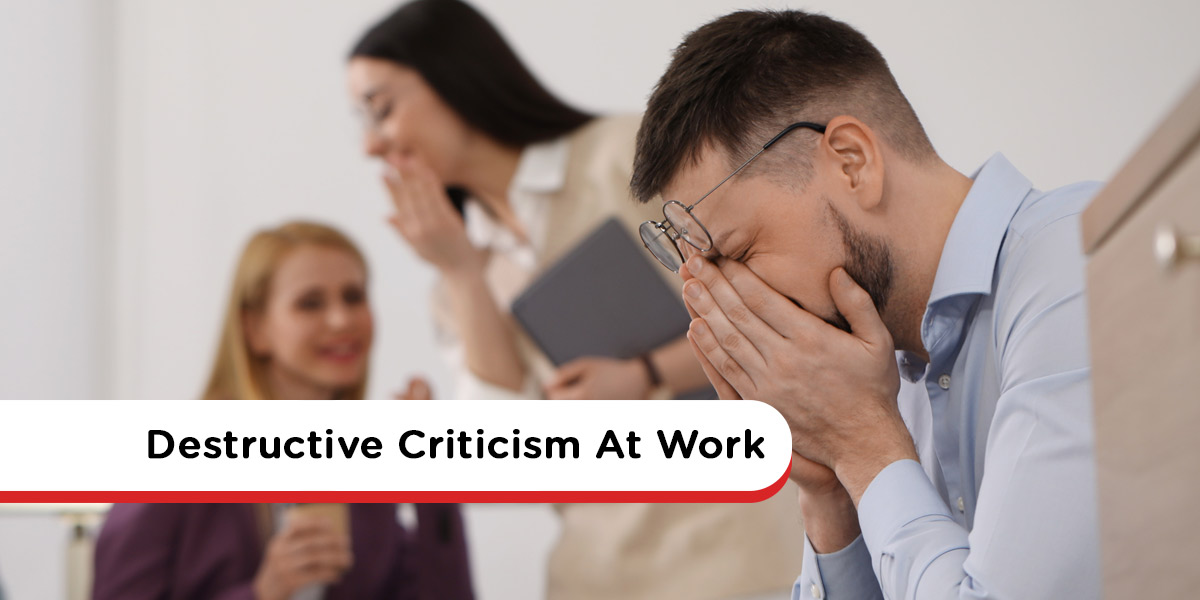
Your New Intranet Starts Here
Streamline communication, boost collaboration, and empower your team with MyHub's intuitive intranet solution.
Book a live demo now and experience the difference.
Take a Quick TourGiving and receiving criticism is an inevitable part of every workplace environment. It plays a crucial role in improving performance and developing employees’ skills and abilities. However, there is a clear distinction between constructive feedback and destructive criticism. While constructive feedback supports growth and improvement, destructive criticism is toxic and harmful to staff morale and productivity.
This post is essential reading for HR professionals, small business owners, and organizational leaders or managers. We explain the key differences between constructive and destructive criticism and share effective strategies to address and manage this damaging issue.
Additionally, we offer practical tips for individuals who are currently dealing with destructive criticism at work, helping them navigate and overcome this challenge.
Constructive vs. Destructive Criticism
To start, let’s clearly define the differences between the two types of criticism. The main factor that separates them is the intention behind the feedback.
What Is Constructive Criticism?
Constructive feedback focuses on helping the individual improve and grow professionally. It is delivered in a friendly, supportive manner and offers specific, actionable suggestions to enhance performance. Constructive criticism avoids blame or finger-pointing and emphasizes problem-solving and raising standards.
What Is Destructive Criticism?
Destructive criticism is usually disrespectful, often taking the form of a personal attack or an emotional outburst. It is undermining, hurtful, and typically lacks specific guidance. For example, calling a colleague “stupid” for making a mistake is destructive, whereas a constructive approach would calmly explain where the error occurred and offer helpful advice for improvement.
How To Tell The Difference?
Sometimes even constructive criticism can sound negative, so how do you recognize when feedback has crossed the line into destructive criticism? Use this checklist to identify the key differences:
Intent
Consider the intention behind the feedback. If the goal is to be helpful and supportive, the criticism is constructive. However, if the purpose is to harm, embarrass, or offend the recipient, it is destructive.
Delivery
The tone of voice and word choice are telling. Constructive criticism is delivered in a friendly and helpful manner, aiming for growth. In contrast, destructive criticism often sounds like a personal attack rather than an opportunity for improvement.
Areas Criticized
Constructive criticism targets specific actions or work-related shortcomings. Destructive feedback, however, is vague and focuses on personal attributes rather than behaviors or results.
Help
Constructive criticism always includes helpful tips and actionable suggestions. Destructive criticism offers no such benefits and leaves the recipient feeling demoralized and unsupported.
Destructive Criticism At Work
Some managers may underestimate the seriousness of destructive feedback in the workplace, suggesting employees should simply toughen up and develop thicker skin. While it’s true that receiving any kind of criticism, even constructive feedback, can be challenging for some employees, the effects of destructive criticism extend far beyond a bruised ego. It can seriously harm the individual’s mental well-being and self-esteem, while also negatively impacting the entire team by fostering a toxic work environment.
Allowing destructive criticism to go unchecked can have severe and wide-reaching consequences. Here are some of the main negative impacts it can cause.
Team Cohesiveness
Destructive criticism within a team causes members to become defensive and withdrawn. This directly harms team collaboration, communication, and morale. Such negativity acts as a barrier to the free exchange of ideas, resulting in decreased productivity and inefficient workflows. When trust and openness break down, the entire team suffers.
Conflict Within The Team
If negative feedback is not addressed, it can quickly escalate into open team conflicts. Employees feeling attacked often respond defensively with counterattacks, further fueling hostility. Over time, this division may lead to factions forming, forcing colleagues to pick sides and severely damaging team unity and trust.
Performance
Individuals differ in their ability to receive criticism, but even constructive feedback can sometimes be taken personally. Destructive criticism has far more damaging effects, eroding confidence and severely affecting job performance. At its worst, it can contribute to serious mental health issues such as anxiety and depression. Employees constantly undermined by negativity may ultimately decide to leave the organization, increasing turnover and loss of valuable talent.
Toxic Environment
Like a contagious virus, negativity from destructive criticism can spread throughout the workplace, creating a toxic work environment. Common symptoms include increased absenteeism, high rates of sickness, and widespread dissatisfaction. Staff turnover rises sharply, while overall productivity and company profits inevitably decline.
Destructive Criticism Examples
It’s essential for business owners, HR professionals, and managers to recognize and address destructive criticism early, before it escalates into a serious problem. Here are some common examples you might encounter in the workplace.
Bullying
Workplace bullying is more prevalent than many realize and can take many forms. According to one study, 30 percent of respondents reported experiencing abusive conduct at work, while 66 percent witnessed bullying behaviors. Bullying often involves someone in a position of power using it to harass or intimidate others but can also occur between peers. It may sometimes be driven by underlying issues such as sexism or racism.
Unintentional Destructive Criticism
Sometimes harsh or careless remarks are made in the heat of the moment without malicious intent. However, even unintentional destructive criticism can be deeply hurtful to recipients. The intention might be helpful, but poor delivery causes offense. Regardless of intent, it’s important to recognize and address such feedback to prevent ongoing harm.
Destructive Criticism From Subordinates
This form of negative feedback from employees occurs when subordinates reject the authority of managers or project leaders. Often fueled by personal grudges, prejudice, or perceived managerial incompetence, it can undermine leadership and disrupt team dynamics.
Team Conflict
When relationships between co-workers break down, it can trigger destructive behaviors on both sides. Sneering negativity, passive-aggressive actions, and even sabotage can rapidly spiral out of control, leading the team to turn against one another or the leadership, harming overall team cohesion and effectiveness.
4 Effective Strategies For Managing Destructive Criticism at Work
When it comes to tackling damaging feedback in the workplace, the responsibility ultimately falls on business owners and managers. Proactively addressing destructive criticism is essential to maintaining a healthy, productive team environment. The following four proven strategies will help you prevent this issue from escalating and protect your workplace culture.
1. Take Swift Action
This is not the time to ignore or avoid the problem. To ensure destructive criticism does not become a destabilizing force, you need to intervene promptly. As soon as you identify damaging feedback, step in decisively to address it.
Reinforce positive behaviors by establishing clear team communication guidelines. These guidelines set clear expectations for acceptable and unacceptable conduct, helping create a respectful and supportive work atmosphere.
2. Assess The Issue Thoroughly
Before deciding on the best course of action, it’s crucial to carefully assess the situation. Listen to all parties involved to develop a well-rounded, balanced perspective.
Sometimes negative feedback may be unintentional or result from misunderstandings. In these cases, education and personalized coaching can be effective solutions. However, if the situation involves workplace bullying or repeated harmful behavior, more decisive disciplinary measures may be necessary.
Always ensure that employees affected by destructive criticism receive appropriate support to safeguard their well-being.
3. Decide If The Criticism Has Validity
Even when delivered poorly, some destructive criticism may contain valid points. For instance, labeling a colleague as ‘lazy’ might be harsh, but if the individual consistently misses deadlines, the core issue needs addressing.
When criticism has merit but is communicated destructively, find ways to reframe it into constructive feedback. Offer training, development opportunities, or one-on-one support sessions to help the employee improve, fostering growth instead of resentment.
4. Select and Implement a Clear Course of Action
If the criticism is relevant but poorly expressed, have a private conversation with the person delivering the damaging feedback. Understand their motivations—there might be underlying personal issues you can assist with. Document this conversation in their personnel file and clearly outline what behavior is expected within your team.
On the other hand, if the criticism is unfounded or persistently harmful, be prepared to take firmer disciplinary steps to protect the workplace environment. Always reassure the team member on the receiving end that they are supported and that you are actively managing the situation.
Destructive Criticism Strategies For Workers
If you are an employee experiencing destructive criticism in the workplace, it’s important to know that you can take proactive action. Being on the receiving end of negative feedback is never easy and can be emotionally challenging. You might feel tempted to counterattack or internalize the criticism, which can lead to serious mental health issues such as depression or anxiety. The following practical strategies will help you cope effectively and protect your well-being.
1. Try And Ignore It
Our natural reaction to a personal attack is often to retaliate. However, it takes inner strength to pause, review, and reflect on the feedback calmly. First, determine whether the criticism is truly destructive and, if so, whether there is any validity behind it. Sometimes, there may be a grain of truth that can help you grow and improve.
If the feedback is purely destructive with no constructive purpose, ignoring it can be a powerful strategy. Avoid beating yourself up over baseless criticism. Instead, recognize that such criticism reflects more about the critic’s issues than your own performance. You can disarm the attack by refusing to engage or rise to the bait.
2. Confront The Critic
If you feel comfortable and safe, consider raising the issue directly with the person delivering the destructive feedback. This approach can be effective when the criticism is unintentional and the individual is unaware of the harm their words cause.
Arrange a private conversation away from colleagues. Calmly explain how the tone and delivery of their feedback are unhelpful and suggest ways to reframe it into constructive criticism. If your colleague responds positively, you may have resolved the issue. If not, proceed to the next step.
3. Report Problem To HR And Your Manager
If destructive criticism continues despite your efforts, it’s crucial to escalate the matter. Discuss the situation with your manager if possible. If this is not an option or doesn’t resolve the issue, reach out to your company’s HR department. Keep a detailed log of all instances to provide clear evidence.
You should never have to suffer in silence. Reporting the problem to someone with the authority to act is a necessary step to protect your mental wellbeing and workplace harmony.
Destructive Criticism: Key Messages
- Constructive criticism in the workplace is valuable. It supports high-performance standards and helps individuals develop their skills and confidence.
- By contrast, destructive criticism is harmful and personal, focusing on the individual rather than their job performance.
- Left unchecked, destructive criticism can foster a toxic environment, negatively impacting motivation, morale, and overall productivity.
- Managers must take swift action to define acceptable and unacceptable behavior within their teams and address any instances of harmful feedback immediately.
- If you experience ongoing destructive criticism that impacts your mental health and job performance, take control. Keep a detailed record of incidents and involve your line manager or HR to resolve the issue.
For more expert advice, check out MyHub’s blog, packed with insightful articles on today’s most pressing workplace issues. It offers best practice guidance and up-to-date research to help businesses and employees thrive.
MyHub provides easy-to-use cloud intranet solutions to companies worldwide. Our platforms improve communication, enhance collaboration, and boost productivity. Discover how we can help your organization with a free demo or 14-day trial.
FAQ Section
What distinguishes constructive criticism from destructive criticism?
Constructive criticism focuses on specific actions or behaviors with the intent to improve, offering actionable suggestions in a respectful manner. Destructive criticism, on the other hand, targets personal attributes, lacks helpful guidance, and is often delivered in a hurtful or accusatory tone.
How can destructive criticism impact a workplace?
It can lead to decreased employee morale, increased stress, damaged relationships, and a toxic work environment, ultimately affecting productivity and collaboration.
What steps can organizations take to mitigate destructive criticism?
Organizations can establish clear guidelines for providing feedback, offer training on effective communication, encourage a culture of respect and openness, and implement regular feedback mechanisms to ensure continuous improvement.




